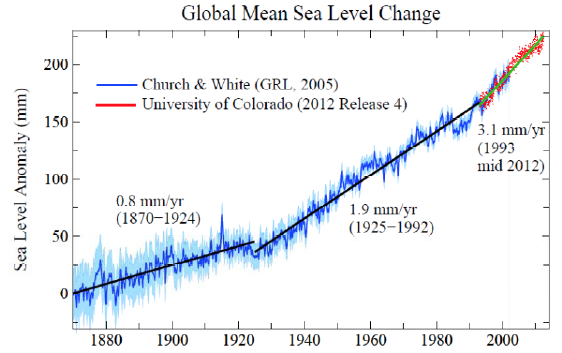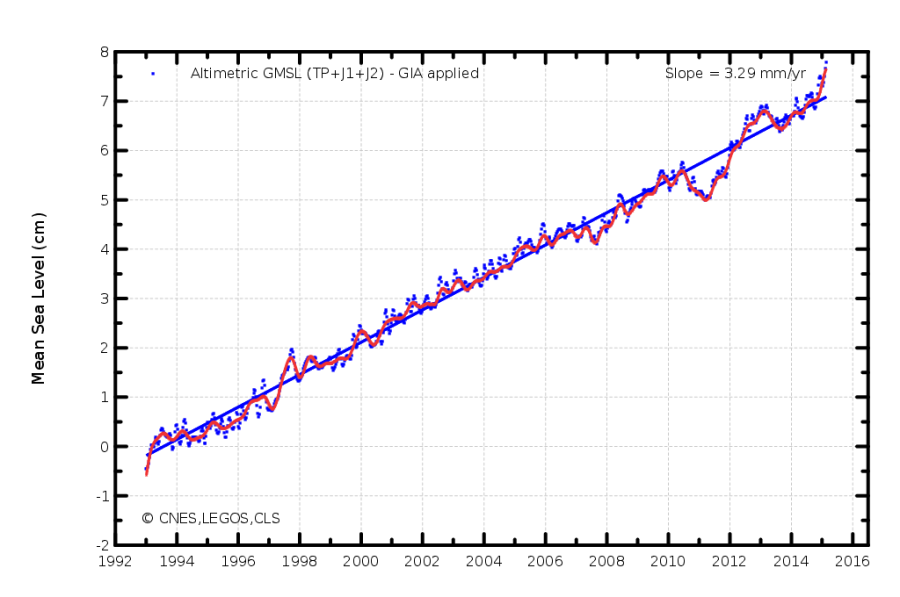Atlantis
Way down
Under the ocean
where I want to be
-Donovan (Atlantis)
Six feet of water
in the streets of Evangenline
- Randy Newman
Greetings
When James Hanson says something, its probably worth listening. Not only has been looking into these maters longer than most, but he is also willing to tell the unvarnished truth see e.g Ballad of the sad climatoligists.So it was with some interest that I listened to an interview he gave in Australia earlier this year, which I found on Ecoshock). Here is a transcript of part of it
"The paleoclimate evidence indicates the ice sheets are much more sensitive than the glaciologist, the modellers of ice sheets have indicated and furthermore we now have satellite data over the last 12 years that confirms that ice sheet disintegration is a non-linear process that should not have been surprising, and I have been saying that for 10 years, but now this satellite data confirms that.
The ice sheets are losing mass faster and faster with a doubling the of about 10 years. If that continues, we would get sea-level rises of several metres within 40 to 50 years."
Several meters? 40-50 years?
This is not what I've been hearing from the IPCC, so it was kind of a rude shock. But it turns out Hanson has been saying stuff like this for some time. see hereWhile the IPCC sees a sea rise in a gentle upslope, Hanson sees it as accelerating much faster,..
(Global sea level rise since 1870. Image source: Dr. James Hansen.)
There may be some support for Hanson's view in recent work. This from Robert Scribbler's blog (see below)
For a recent study, headed by Shuang Yi and published on April 30 in Geophysical Research Letters provides evidence that, since 2010, annual rates of global sea level rise have shown a strong uptick. The study, entitled An Increase in the Rate of Global Mean Sea Level Rise Since 2010, notes:In short, the study finds an average rate of sea level rise of 4.4 mm per year, or 30% faster than the annual rate from 1992 to 2009, during the period of 2010 to 2013."
Sea level rise is a function of both thermal expansion dues to increased temperature, and additional water flows dues to melting Glaciers. Thermal expansion has been the major factor thus far, but by its nature is generally slow. Glaciers on the other hand, can melt rapidly.
It all comes down to doubling time. But every exponential curve starts slow and accelerates. It difficult at the beginning to see which curve the data is following. It may be a slowly changing curve or a rapidly changing one. Thus in one paper Hanson argues.The increasing Greenland mass loss ... can be fit just as well byexponentially increasing annual mass loss, a behavior that Hansen (2005, 2007) argues could occur because of multiple amplifying feedbacks as an ice sheet begins to disintegrate. A 10-year doubling time would lead to 1 meter sea level rise by 2067 ... 2045 ... for 5-year doubling time and 2055 ... for a 7-year doubling time.
Obviously we are not preparing for such rapid sea rises. And it could mean a loss of a lot of coastal property. See Here One aspect that I hadn't given much though to, however, is the impact on commerce - the impacts on ports.
Just to get a feel for how much goes through ports, here is what wiki says
American ports are responsible for moving over 99 percent of the country's overseas cargo.U.S. ports handle a wide variety of goods that are critical to the global economy, including petroleum, grain, steel, automobiles, and containerized goods. Reports from individual ports indicate that approximately 4.6 million automobiles (imports and exports) passed through American ports in 2006.
However the Gulf Coast ports are more significant to the national economy. Noaa points outThe U.S. Department of Transportation (U.S. DOT) initiated another effort to examine the risk to transportation infrastructure from climate change along the Atlantic coast. The study is identifying the transportation infrastructure that, without protection, will regularly be inundated by the ocean or is at risk of periodic inundation due to storm surges. Phase 1 of the report, covering Washington D.C., Maryland, North Carolina, and Virginia, was released in December 2007. In the state of Maryland, the study found that 28% of port acreage would be regularly inundated or at risk of periodic inundation if sea levels rose just 6 cm (2.4 inches)
"Along the Northern Gulf Coast, an estimated 2,400 miles of major roadway and 246 miles of freight rail lines are at risk of permanent flooding within 50 to 100 years as relative sea level is expected to rise in the range of 4 feet (Figure 1). The Gulf Coast is particularly at risk to service disruptions due to a transportation network that is interdependent and relies on minor roads and other low-lying infrastructure. The Gulf Coast is home to seven of the ten largest commercial ports (by tons of traffic) in the country. The region also hosts a significant portion of the U.S. oil and gas industry, with its offshore drilling platforms, refineries, and pipelines. Roughly two-thirds of all U.S. oil imports pass through the Gulf. Sea level rise would potentially affect commercial transportation activity valued in the hundreds of billions of dollars annually through inundation of area roads, railroads, airports, seaports, and pipelines (U.S. Global Change Research Program, 2009). Figure 1 shows the Gulf Coast area roads at risk from sea-level rise.
EPA says
So, Hanson's conclusion looks pretty accurate."Looking particularly at the impact of storm surges, the Gulf Coast Study determines the percentage of marine transportation facilities in an area from Mobile, AL to Galveston, TX that would be affected by certain levels of storm surges. The study predicts that relative sea levels in the region will rise between 0.3 and 7 feet, depending on location, over the coming century. Average temperatures in the region are likely to increase between 0.9°F and 4.5°F over the next fifty years.11 The study provides probabilities for some impacts at the regional level. For example, if relative sea levels rise 4 feet, 72 percent of ports in the region will be at least partially inundated.
For an interesting interactive map of pontential flooding, see here"So spell that out for us James before we move on, sea level rises of several meters in forty years, what would that look like in terms of our livesThe consequences are almost unthinkable. It would mean that all coastal cities would become dysfunctional, some parts of the cities would still be sticking above the water but they would not be habitable, so the economic implications are incalculable. We really cannot go down that path, this is an issue of intergenerational injustice. It’s a moral issue because the current generation is burning the fossil fuel and getting the benefits and creating a situation that for young people, our children and grandchildren and future generations is going to have enormous consequences."
Global Sea Level Rise Going Exponential? New Study Records Big Jump in Ocean Surface Height
Labels: climate, ecoshock radio, Greenland, Hanson, ports, sea level




0 Comments:
Post a Comment
Subscribe to Post Comments [Atom]
<< Home